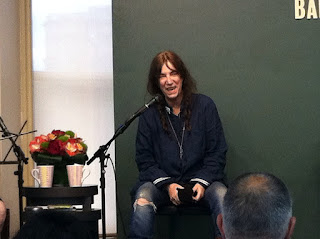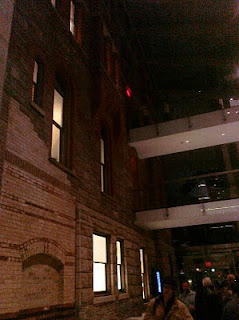Lately I’ve set myself the task of slowly cleaning out my house, bit by bit. In the process, I’ve run across a fair amount of stuff that’s reminded me of my younger days: an old sweater, a pair of earrings, high heels.
“I wore this to that show,” I’m reminded, “and I remember loving this look at that party.”
Alas, I can’t remember quite what I wore to see Stone Temple Pilots when they played Toronto’s historic Masonic Temple (then a concert venue) back in the early 1990s. It was winter, and awfully cold in the hall, at least until the concert started, when it got steamy; whatever I wore, it was layered, and one by one, those layers, like those of my youthful self-consciousness, were peeled off as the show progressed, until I was left in a tank top, shrieking, sweaty, and wild-eyed at an amazing, beautiful, pure rock-and-roll sound that stays with me to this day.
I’d seen other bands in small and big venus before, but the crowd for STP was different — saucier, louder, more diverse, with a whole lot more young women, one of whom, I distinctly remember, mixed high-waisted mom jeans (then deeply unfashionable) with a tight hornet-green tank top and wayfarer sunglasses. She knew every word of every song, and rocked out from her front-balcony position, trading points and gestures with Scott Weiland now and again, as the lead singer stalked around the space, spitting, crooning, gesticulating wildly; seducing us one moment and ready to punch us the next, he was, unlike so many other figures I’d seen live or on TV, seemingly unconcerned with garnering good opinions. And he was, I suspect, for so many in the audience that night, me and mum-jeans girl included, the antihero we didn’t quite realize we wanted, but nonetheless found ourselves gravitating towards. We may’ve been outsiders beyond the walls of the Masonic Temple, but we were welcomed within it that night.
Stone Temple Pilots were just emerging as a loud rock outfit back then, with a few elements of the then-huge grunge sound, trying to get out from under the overbearing mound of Pearl Jam comparisons. They’d made a few videos but no one could quite get a handle on them, except of course, to compare them to others, and to try to strip them of any semblance of originality. Even at the time (never mind in retrospect), it seemed wildly unfair and frustratingly reductive. They were deeply of and yet simultaneously beyond their time. As Rob Harvilla noted, the band became, by the mid-90s, “the armadillo-trousered ’70s arena-rockers of their dreams, a T.Rex for the Jurassic Park era.”
As someone who grew up deep into pop as well as the classic sounds of Motown, jazz, and of course, opera, rock and roll was a bit of at thing apart in my house; Queen was okay, Metallica was not. My gravitation toward rock and roll coincided with the rise of so-called grunge and I loved “Sex Type Thing” and “Plush” the first time I heard them— the raw, bitingly aggressive sarcasm of the former, the swirling, surreal sensuality of the latter (and still do) — they’re thrilling pieces within the rock pantheon. As years went on, my love of the band’s work wavered, but the one thing I always loved, through “Big Empty” and “Interstate Love Song” and “Vasoline” and “Big Bang Baby”, through the cacophony of noise both in and outside the band, was the wonderful husky bray of Weiland’s voice, a lush baritone call that could be romantically plaintive one moment and blazingly angry the next. It was a voice made for rock and roll, made for belting not above but inside the noisy guitars and thumping bass lines and thrashing drums, straight into the minds and hearts of listeners. It’s a voice that still makes me pause in a way that very few in the rock world do. I wish I’d heard it live more often.
Pop culture is littered with figures who serve as torch-bearers for people who feel the world doesn’t understand them. But such a position feels too cliched for someone as vulnerable and self-loathing as Weiland. The last decade or so, he simply didn’t look like he had the strength to be any kind of torch-bearer, much less the desire. He wanted to be a rock star, and he was, but he was much more, too. I watched him slink off the stage that night, long ago, and as the lights were just coming up, a thought hit me, quite suddenly, that he looked so small and so damn lonely. I suspect Weiland cared a great deal about what others thought — what artist doesn’t? — and found himself thrown aside, like so much useless detritus. I’d rather not be the one carrying bones of a beloved antihero into some highly stylized, steampunk version of eternity; unbundling the mundane details of a present reality is always more complicated. Weiland passed away at the age of 48, not 27, and had neither burned out nor faded away, but he was clearly damaged, for so many reasons, many of them made baldly public.
We all carry a certain amount of damage around. As I continue clearing out my house of old mementoes, I’m reminded of the person I was then, and can’t help but compare that girl, with all of her insecurities and anxieties, with the woman I am now. Some of the old worries are still there, but many have been replaced, if not vanished entirely. Damage isn’t something I want to romanticize, but it isn’t something to ignore, either; some very eye-widening things can result from some very horrific things. It’s not my place to draw lines between Weiland’s life and his art, and now, alas, his legacy — but I know one thing for certain: he was the first rock star I saw live who really made me lose my shit, but at the same time, made me think about… everything. I came out into the cold winter air after STP’s show that night bathed in sweat, and, for weeks afterwards, kept thinking about him, his voice, the show, that girl in the mom-jeans. Rock and roll has real power; every time I hear his voice, I’m reminded of that. It’s the most obvious thing in the world, and yet it bears repeating. it’s time to put on Core, Purple, and all the rest; it’s time to feel the power again.



